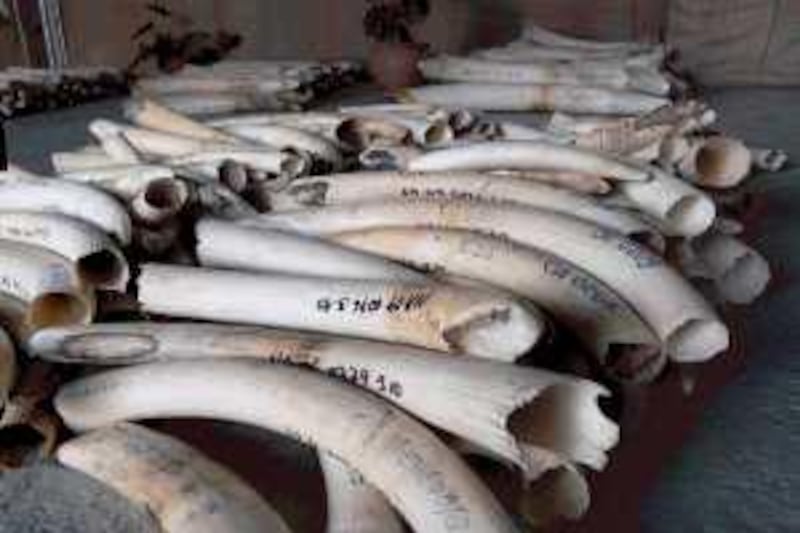BULAWAYO, ZIMBABWE // Organised syndicates of poachers are killing wildlife in Zimbabwe's animal parks - some species to near extinction - a situation that worries conservationists and tourism operators. Armed with assualt rifles, hi-tech communication and spying equipment, commercial poachers mainly target elephants and rhinos for their horns, and giraffe and zebra for their skins. Poor subsistence poachers who are mostly locals use wire snares to capture plains game for meat.
At Chipangali Wildlife Orphanage, 25km east of here, where dozens of abandoned, orphaned and sick animals are kept, all the rhinos have been poached. Johnny Rodrigues, chairman of the Zimbabwe Conservation Taskforce, said poverty, greed and a breakdown in law and order are driving illegal hunting. Zimbabwe had about 1,000 rhinos 20 years ago, he said, but only 400 of the endangered species are left, after most of them had been poached.
"The problem is big and the losses are far higher than the US$5 million [Dh18.3m] given by the government. "Nobody is policing people in high places who are running the highly organised poaching rackets. They say the army and police have been engaged to fight poachers, but soldiers are also poorly paid and are actually poaching." In June, the government said $5m in potential revenue had been lost to poaching since January.
Areas hardest hit by rhino poachers are Lake Chivero, near Harare, and parks in the central, western and south-eastern parts of the country. Rhino horns and elephant tusks are smuggled to South Africa, Europe and China, while zebra and giraffe skins are sold in South Africa. Rhino horns are used to make medicine and aphrodisiacs in Asia. In the Middle East they are used to make handles for ceremonial daggers.
Mr Rodrigues said a kilogram of rhino horn could fetch $4,000 (Dh14,700), while an elephant tusk was worth between $500 and $2,000, depending on quality. Amid the carnage, Zimbabwe now faces possible censure at the March 2010 Convention on International Trade in Endangered Species (Cites) meeting to be held in Doha. Cites is a global organisation that controls trade and exploitation of rare species of flora and fauna.
Morris Mtsambiwa, the director general of Zimbabwe's Parks and Wildlife Management Authority, recently said he was concerned about resurgent poaching, especially targeting the rhino. "Rhino poaching has put Zimbabwe in the spotlight within the framework of Cites," he told The Herald, a government-run daily. "Rhino poaching is now becoming a very serious problem for us. "Over the past few years we have seen an upsurge in poaching activities. We are facing organised poaching run by syndicates from the region that are now working in cahoots with locals."
The parks authority has enlisted the army and police to complement its own anti-poaching unit in repelling illegal hunters. It is also de-horning the rhinos to discourage killings. The International Rhino Federation, a conservation group based in Florida, said eight poachers had been killed this year. In a recent case, not captured in the federation's report, a suspected Zambian illegal hunter was captured after a shoot-out with rangers in the game-rich Mana Pools, 400km west of Harare.
The rangers recovered an AK47 assault rifle, 237 live rounds of ammunition and seven elephant tusks from the suspect. Raoul du Toit, the director of Zimbabwe's Lowveld Rhino Trust, told the International Rhino Foundation website recently: "In the Midlands Conservancy, for example, the black rhino population has declined from 45 a few years ago to about five animals now." Zimeye.com, a Zimbabwean online publication, recently reported that ministers Emmerson Mnangagwa and Webster Shamu were being investigated for alleged poaching of elephant and rhino, but dockets of their cases had mysteriously disappeared.
Operators in the country's wildlife-based tourism industry are also alarmed at the escalating poaching. Paul Matamisa, the proprietor of Marondera Hotel, 70km north-east of Harare, said 90 per cent of local tourism was wildlife-based. So if the animals are depleted, the sector would lose its competitiveness, he said. "Without wildlife, we do not have a tourism industry to talk of," said Mr Matamisa, the former chief executive of Zimbabwe Council for Tourism (ZCT), a union of local tourism operators.
Tourism contributes three per cent to the gross domestic product and brings $50m annually to the economy, according to ZCT statistics . Mr Rodrigues called for higher fines and lengthy jail sentences for poachers. He said the fine that offenders pay must match the price of the hunting trophies of the animals they would have killed. For example, one who poaches an impala, for which a safari hunter pays $700, must pay the same amount as fine.
"If the massacre continue like this, what will tourists see when they come to Zimbabwe?" asked Mr Rodrigues. "Animals on three legs?" foreign.desk@thenational.ae





